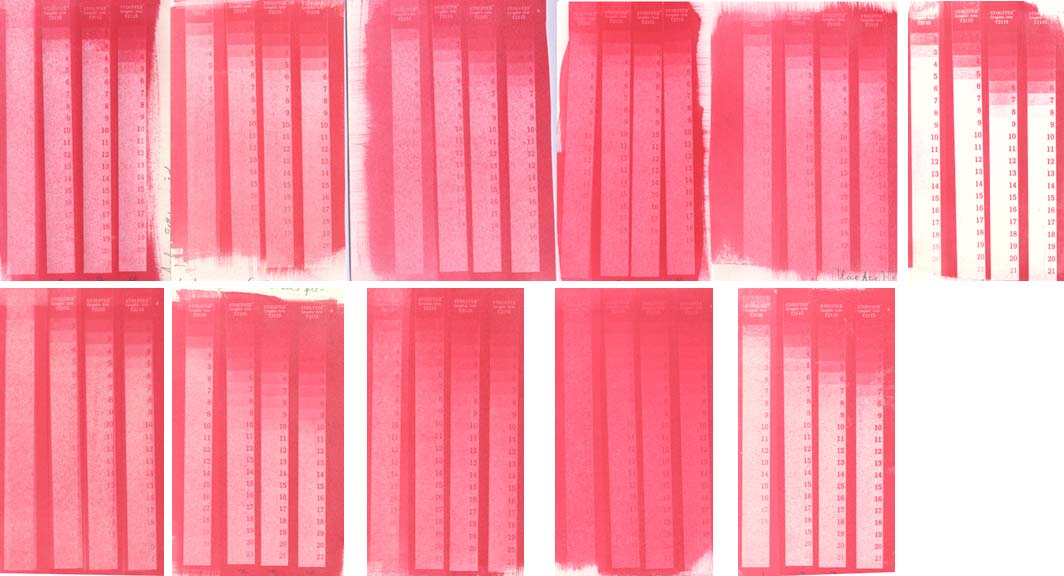
Relationship between Pigment Stain and Exposure?
It has been said that an underexposed gum layer is more likely to stain than a properly exposed gum layer or an overexposed one, or more generally, that pigment stain is related to exposure in an inverse fashion: the less exposure, the more stain, and vice versa.
Below, I chose four papers that I thought likely to stain, and two papers I thought wouldn't stain, coated them with the same mixture of PR 209, gum and dichromate, and exposed four test strips on each one, at 1, 2, 3, and 4 minutes (this range encompasses underexposure, correct exposure, and overexposure for my system and humidity) to try to see a difference in stain as a result of a variation in exposure. The results are below:

Top row:
Exposures of 1, 2, 3, and 4 minutes, left to right, on each of six papers, left to right: Arches 90#, Arches 140#, Fabriano Artistico (the old Fabriano Artistico), Fabriano Uno (all unsized); Fabriano Uno, sized with acrylic medium; Arches bright white, sized with gelatin and glyoxal. The optimal exposure will vary from paper to paper, and with relative humidity, but for the relative humidity at the time (75%), on my equipment and with this emulsion, the average optimal exposure would be around 2 to 2.5 minutes, so the 1 to 4 minute exposures can be assumed to encompass underexposure, correct exposure, and overexposure. All were developed between 1 to 2.5 hours, to produce a reasonable step print for the 4 minute exposure. Pigment: PR 209, quinacridone red. Pigment/gum: saturated ammonium dichromate, 1:1.
As you can see, where stain is present, it is present in equal intensity across the four exposures, and in the one case here where stain is not present, it is equally absent across all exposures. It appears that varying exposure does not have any noticeable effect on stain's presence or intensity; in other words, the idea that stain is related in an inverse fashion to exposure, is not supported by these tests.
Bottom row:
Same papers, same exposures, but this time the emulsion was "flashed" before exposing through the test strips, to test the assertion that some minimal exposure will reduce the likelihood of stain. The times for flashing are, left to right, 5 seconds, 10 seconds, and the rest are 20 seconds. I settled on 20 seconds because it seemed from the Uno acrylic paper (far right) that the flashing at that duration might have some attenuating effect on stain without adding significant tone. However, this effect was not seen on the other papers, and I don't trust the seeming effect on Uno, since another piece cut from this same sheet of paper printed a tricolor stainfree with no preflashing. So I can't have any confidence that the apparent difference in stain between the flashed and unflashed Uno/acrylic samples can be attributed to the flashing. Since four of the five papers show no attenuation of stain associated with flashing, and the apparent attenuation on the fifth one is uninterpretable and incomplete, I would say that this test fails to support the assertion that some minimal exposure will provide a base of hardened gum that will keep the pigment from sinking into the paper, thus preventing stain.
As a separate check on the flashing time, I flashed a piece of sized paper (same paper as far right above) for 10, 20, and 30 seconds and found that there was noticeable tone (after 1.5-hour development) even from 10 seconds, not much more at 20 seconds, and a significant amount of tone from a 30-second flashing. So it seems that 20 seconds (for my conditions and equipment) would be the maximum flashing that could be considered possibly useful for this test. In order for the principle to be useful in practice, the exposure would have to protect the paper from stain in white areas without adding tone. The goal in preventing stain would be to protect highlights and paper whites, as those are the places where stain is most noticeable, so to add tone to paper white in order to prevent stain, in other words to trade stain in for tone, would be rather to defeat the purpose. So I doubt that anything useful for practice can be found along this line of inquiry.
The tentative conclusion that paper-related pigment stain is unrelated to exposure within the tolerances of normal gum practice should not be generalized to pigment-related pigment stain which seems to be a bit more complicated, as in the case of tonal inversion. I've only ever been able to produce tonal inversion on well-sized paper, and on glass and yupo, so I think it belongs securely in the second category. And for that matter, tonal inversion is also outside the range of normal gum practice, as has been pointed out.
Copyright Katharine Thayer, all rights reserved.